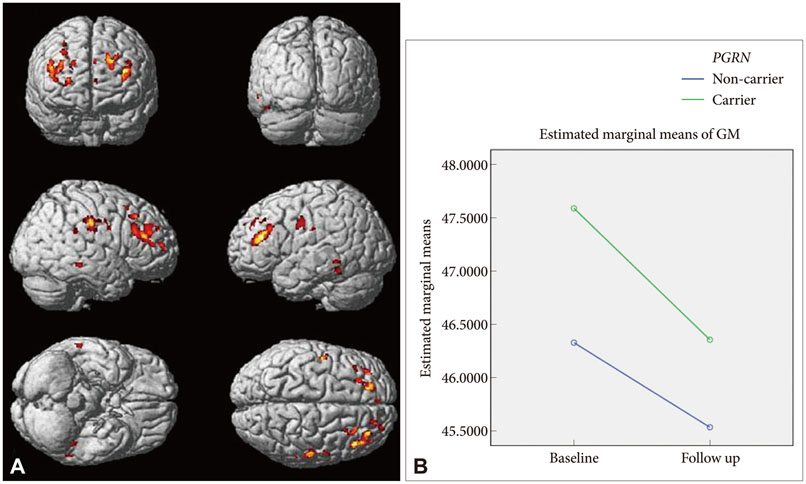Dement Neurocogn Disord.
2015 Dec;14(4):163-167. 10.12779/dnd.2015.14.4.163.
A Voxel Based Morphometric Analysis of Longitudinal Cortical Gray Matter Changes in Progranulin Mutation Carriers At-Risk for Frontotemporal Dementia: Preliminary Study
- Affiliations
-
- 1Department of Neurology, College of Medicine, Chung-Ang University, Seoul, Korea.
- 2Division of Neurology, Department of Medicine, University of British Columbia, Vancouver, BC, Canada. neudoc@gmail.com
- KMID: 2442934
- DOI: http://doi.org/10.12779/dnd.2015.14.4.163
Abstract
- BACKGROUND AND PURPOSE
One of the most common genetic causes of frontotemporal dementia (FTD) is mutation in the progranulin (PGRN) gene. The aim of this study is to assess the early effects of the PGRN mutations on brain volumes by longitudinal voxel based morphometric (VBM) evaluation in asymptomatic mutation carriers.
METHODS
We recruited 17 asymptomatic members of families with FTD caused by PGRN mutations; 7 mutation carriers (51.0+/-11.6 yr) and 10 non-carriers (55.2+/-6.0 yr, p=0.404). The MRI follow-up intervals of carriers and non-carriers were 788.6+/-103.8 and 922.0+/-225.1 days (p=0.124) respectively. We performed cross-sectional and longitudinal VBM analysis on both groups.
RESULTS
At baseline, the carriers had lower white matter (WM) volumes in left frontal regions (p<0.001, uncorrected), but had no gray matter (GM) volume reduction. The carrier's global GM (p=0.924) and WM volume (p=0.364) reduction rate were not different from the non-carrier's. However, statistical parametric mapping T-maps showed differentially increased GM volume reductions in the bilateral parietal areas of carriers (p<0.001, uncorrected).
CONCLUSIONS
The findings from this study to examine WM and GM cross-sectional and longitudinal changes in PGRN mutation carriers suggest that WM atrophic changes could precede both GM changes and symptom onset in FTD. Asymptomatic PGRN mutation carriers have measurably higher rates of regional GM atrophy than non-carriers even in the pre-dementia stages.
Keyword
MeSH Terms
Figure
Reference
-
1. Chow TW, Miller BL, Hayashi VN, Geschwind DH. Inheritance of frontotemporal dementia. Arch Neurol. 1999; 56:817–822.
Article2. Rizzu P, Van Swieten JC, Joosse M, Hasegawa M, Stevens M, Tibben A, et al. High prevalence of mutations in the microtubule-associated protein tau in a population study of frontotemporal dementia in the Netherlands. Am J Hum Genet. 1999; 64:414–421.
Article3. Rademakers R, Cruts M, van Broeckhoven C. The role of tau (MAPT) in frontotemporal dementia and related tauopathies. Hum Mutat. 2004; 24:277–295.
Article4. Baker M, Mackenzie IR, Pickering-Brown SM, Gass J, Rademakers R, Lindholm C, et al. Mutations in progranulin cause tau-negative frontotemporal dementia linked to chromosome 17. Nature. 2006; 442:916–919.
Article5. Cruts M, Gijselinck I, van der Zee J, Engelborghs S, Wils H, Pirici D, et al. Null mutations in progranulin cause ubiquitin-positive frontotemporal dementia linked to chromosome 17q21. Nature. 2006; 442:920–924.
Article6. Pickering-Brown SM, Rollinson S, Du Plessis D, Morrison KE, Varma A, Richardson AM, et al. Frequency and clinical characteristics of progranulin mutation carriers in the Manchester frontotemporal lobar degeneration cohort: comparison with patients with MAPT and no known mutations. Brain. 2008; 131(Pt 3):721–731.
Article7. Whitwell JL, Jack CR Jr, Baker M, Rademakers R, Adamson J, Boeve BF, et al. Voxel-based morphometry in frontotemporal lobar degeneration with ubiquitin-positive inclusions with and without progranulin mutations. Arch Neurol. 2007; 64:371–376.
Article8. Huey ED, Grafman J, Wassermann EM, Pietrini P, Tierney MC, Ghetti B, et al. Characteristics of frontotemporal dementia patients with a Progranulin mutation. Ann Neurol. 2006; 60:374–380.
Article9. Rohrer JD, Warren JD, Omar R, Mead S, Beck J, Revesz T, et al. Parietal lobe deficits in frontotemporal lobar degeneration caused by a mutation in the progranulin gene. Arch Neurol. 2008; 65:506–513.
Article10. Le Ber I, Camuzat A, Hannequin D, Pasquier F, Guedj E, Rovelet-Lecrux A, et al. Phenotype variability in progranulin mutation carriers: a clinical, neuropsychological, imaging and genetic study. Brain. 2008; 131(Pt 3):732–746.
Article11. Beck J, Rohrer JD, Campbell T, Isaacs A, Morrison KE, Goodall EF, et al. A distinct clinical, neuropsychological and radiological phenotype is associated with progranulin gene mutations in a large UK series. Brain. 2008; 131(Pt 3):706–720.
Article12. Borroni B, Alberici A, Premi E, Archetti S, Garibotto V, Agosti C, et al. Brain magnetic resonance imaging structural changes in a pedigree of asymptomatic progranulin mutation carriers. Rejuvenation Res. 2008; 11:585–595.
Article13. Cruchaga C, Fernández-Seara MA, Seijo-Martínez M, Samaranch L, Lorenzo E, Hinrichs A, et al. Cortical atrophy and language network reorganization associated with a novel progranulin mutation. Cereb Cortex. 2009; 19:1751–1760.
Article14. Gass J, Prudencio M, Stetler C, Petrucelli L. Progranulin: an emerging target for FTLD therapies. Brain Res. 2012; 1462:118–128.
Article
- Full Text Links
- Actions
-
Cited
- CITED
-
- Close
- Share
- Similar articles
-
- A Voxel-Based Morphometry of Gray Matter Reduction in Patients with Dementia of the Alzheimer's Type
- Voxel-Based Morphometry Study of Neurodegenerative Disease with Abnormal Eating Behaviors
- Reduced Gray Matter Volume in Subjective Cognitive Decline: A Voxel-Based Morphometric Study
- Voxel-Based Morphometry Study of Gray Matter Abnormalities in Neurodegenerative Disease with Obsessive-Compulsive Behaviors
- Dissociation of Structural and Functional Integrities of the Motor System in Amyotrophic Lateral Sclerosis and Behavioral-Variant Frontotemporal Dementia



